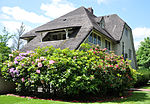Equestrian statue of Joan of Arc (Portland, Oregon)
1925 establishments in OregonBronze sculptures in OregonCopper sculptures in OregonCultural depictions of Joan of ArcEquestrian statues in Oregon ... and 9 more
Granite sculptures in OregonLaurelhurst, Portland, OregonMiddle Ages in popular cultureMonuments and memorials in Portland, OregonNortheast Portland, OregonOutdoor sculptures in Portland, OregonSculptures of women in OregonWorks about Joan of ArcWorld War I memorials in the United States

Joan of Arc, also known as Joan of Arc, Maiden of Orleans, is an outdoor copy of Emmanuel Frémiet's equestrian statue Jeanne d'Arc (1874), installed in Portland, Oregon's Laurelhurst neighborhood, in the United States. The bronze sculpture, which depicts Joan of Arc, was donated to the city by Henry Waldo Coe, who saw Frémiet's original statue in Paris. Portland's copy arrived from France in 1924 and was dedicated on Memorial Day in 1925 in honor of the Doughboys of World War I.
Excerpt from the Wikipedia article Equestrian statue of Joan of Arc (Portland, Oregon) (License: CC BY-SA 3.0, Authors, Images).Equestrian statue of Joan of Arc (Portland, Oregon)
Coe Circle, Portland Laurelhurst
Geographical coordinates (GPS) Address Nearby Places Show on map
Geographical coordinates (GPS)
| Latitude | Longitude |
|---|---|
| N 45.52633 ° | E -122.62301 ° |
Address
Jeanne d'Arc Memorial
Coe Circle
97232 Portland, Laurelhurst
Oregon, United States
Open on Google Maps










